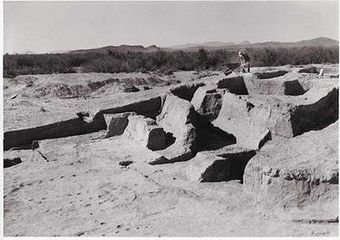Gatlin Site facts for kids
|
Gatlin Site
|
|

Gatlin Site excavation, 1958-1962. Photo courtesy Arizona State Museum.
|
|
| Lua error in Module:Location_map at line 420: attempt to index field 'wikibase' (a nil value). | |
| Nearest city | Gila Bend, Arizona |
|---|---|
| Built | 900 A.D. |
| NRHP reference No. | 66000183 |
Quick facts for kids Significant dates |
|
| Added to NRHP | October 15, 1966 |
| Designated NHL | July 19, 1964 |
The Gatlin Site is a really old place in Gila Bend, Arizona. It's an archaeological site, which means it's where people find clues about how ancient people lived. This site is special because it has one of the few known platform mounds built by the Hohokam people.
Around this mound, archaeologists found old pit houses where people lived. They also found special courts for playing a ball game, and middens, which are like ancient trash heaps. There were even old canals for watering crops!
Contents
What is the Gatlin Site?
The Gatlin Site was a very important village for the Hohokam people. It was active between about 800 AD and 1200 AD. This was a busy time at the big bend of the Gila River. The Hohokam were the first farmers in southern Arizona. They used the Salt and Gila Rivers to water their crops in the hot desert.
A Big Hohokam Village
The Gatlin Site was the largest village in its area. More than 500 people lived there. Its importance is clear because it had two ceremonial ball courts. It also had one of the earliest platform mounds ever found. This mound is special because it's still in good shape. It's one of the few from the Sedentary Period that archaeologists have studied well.
A National Historic Landmark
Because of its importance, the Gatlin Site was named a National Historic Landmark in 1964. This means it's a place that tells a big part of America's history.
Discovering the Gatlin Site
The Gatlin Site was found when people were looking for places to build the Painted Rock Dam. This was done by the United States Army Corps of Engineers. The first digs at the site happened in 1959 and 1960.
Where is it Located?
The site sits on a high area above the Gila River. At the time it was found, the land belonged to a rancher named Colin Gatlin. An archaeologist named Norton Allen had been interested in this area for a long time. In 1937, he noticed the mound but didn't know how important it was.
The Gatlin Site Today
Today, the Gatlin Site belongs to the town of Gila Bend. The town is working to turn it into a cultural park for everyone to visit. This park will help people learn about the ancient Hohokam people and their way of life.

